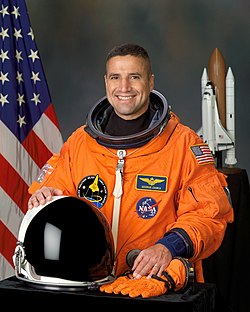George Zamka
| George Zamka | |
|---|---|
 | |
| NASA Astronaut | |
| Statsborger | USA |
| Nationalitet | |
| Status | Aktiv |
| Født | 29. juni 1962 (58 år) Jersey City, New Jersey, USA |
Andet arbejde | Testpilot |
| Uddannelses- sted | Florida Institute of Technology U.S. Air Force Test Pilot School United States Naval Academy Rochester Adams High School |
Tid i rummet | 15 dage 2 timer 23 minutter |
| Udvælgelse | NASA-gruppen fra 1998 |
| Mission(er) | STS-120, STS-130 |
| Missionsemblemer | |
George David "Zambo" Zamka (født 29. juni 1962) er en amerikansk NASA-astronaut, som var med på rumfærgen Discovery i oktober 2007 på mission STS-120 til Den Internationale Rumstation. Han blev i juni 1998 udvalgt til NASA-astronaut, og begyndte sin træning i august samme år.
Han er med som kaptajn på mission STS-130 i februar 2010.
Eksterne henvisninger
| Spire Denne biografi om en amerikaner er en spire som bør udbygges. Du er velkommen til at hjælpe Wikipedia ved at udvide den. |
Medier brugt på denne side
Colonel George D. Zamka, USMC, NASA astronaut
The STS-120 patch reflects the role of the mission in the future of the space program. The shuttle payload bay carries Node 2, the doorway to the future international laboratory elements on the International Space Station. On the left the star represents the International Space Station; the red colored points represent the current location of the P6 solar array, furled and awaiting relocation when the crew arrives. During the mission, the crew will move P6 to its final home at the end of the port truss. The gold points represent the P6 solar array in its new location, unfurled and producing power for science and life support. On the right, the moon and Mars can be seen representing the future of NASA. The constellation Orion rises in the background, symbolizing NASA's new exploration vehicle. Through all, the shuttle rises up and away, leading the way to the future.
The official patch for STS-130. The shape of the patch represents the Cupola, which is the windowed robotics viewing station, from which astronauts will have the opportunity not only to monitor a variety of ISS operations, but also to study our home planet. The image of Earth depicted in the patch is the first photograph of the Earth taken from the moon by Lunar Orbiter I on August 23, 1966. As both a past and a future destination for explorers from the planet Earth, the moon is thus represented symbolically in the STS-130 patch. The Space Shuttle Endeavour is pictured approaching the ISS, symbolizing the Space Shuttle's role as the prime construction vehicle for the ISS.




